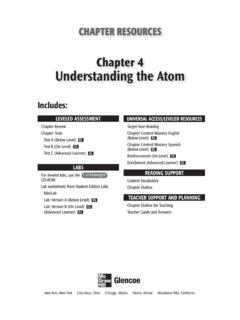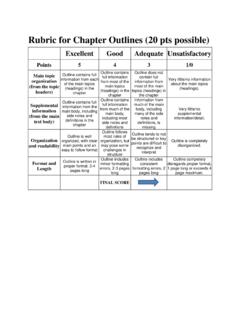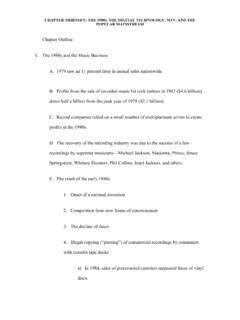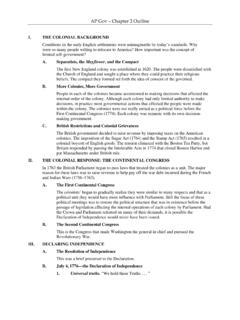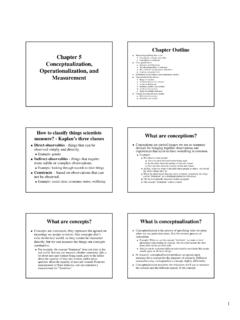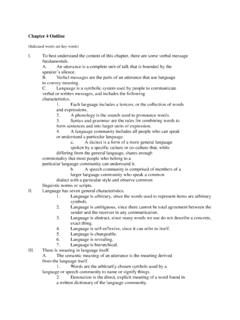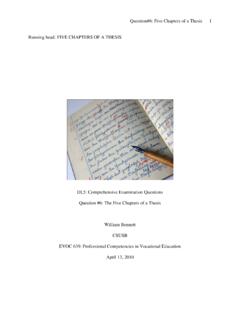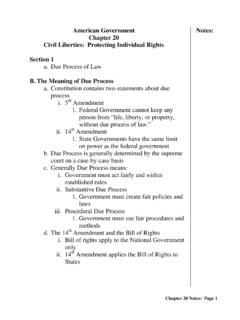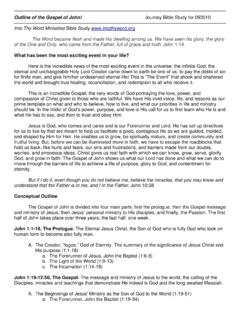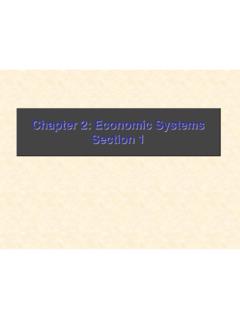Transcription of Chemical Reaction; Grade 8 Chapter 8 - Fairfax School District
1 Chapter 8 Chemical ReactionsLEVELED ASSESSMENT Chapter Review Chapter Tests Test A (Below Level) BL Test B (On Level) OL Test C (Advanced Learner) ALLABS For leveled labs, use the CD-ROM. Lab worksheets from Student Edition Labs MiniLab Lab: Version A (Below Level) BL Lab: Version B (On Level) OL (Advanced Learner) ALUNIVERSAL ACCESS/LEVELED RESOURCES Target Your Reading Chapter Content Mastery English (Below Level) BL Chapter Content Mastery Spanish (Below Level) BL Reinforcement (On Level) OL Enrichment (Advanced Learner) ALREADING SUPPORT Content Vocabulary Chapter OutlineTEACHER SUPPORT AND PLANNING Chapter Outline for Teaching Teacher Guide and AnswersIncludes: Chapter RESOURCES8-08-i-vi-MSSCA07-875464 i2/9/06 2:32:34 PM Glencoe SciencePhoto CreditsCover.
2 Roger Ressmeyer/CORBIS Copyright by The McGraw-Hill Companies, Inc. All rights is granted to reproduce the material contained herein on the condition that such material be reproduced only for classroom use; be provided to students, teachers, and families without charge; and be used solely in conjunction with the Glencoe Science program. Any other reproduction, for use or sale, is prohibited without prior written permission of the all inquiries to:Glencoe/McGraw-Hill8787 Orion PlaceColumbus, OH 43240-4027 ISBN-13: 978-0-07-875464-7 ISBN-10: 0-07-875464-XPrinted in the United States of 3 4 5 6 7 8 9 10 009 11 10 09 08 07 06 Contents iiiCopyright Glencoe/McGraw-Hill, a division of The McGraw-Hill Companies, of ContentsAdditional Assessment Resources available with Glencoe Science.
3 ExamView Assessment Suite Assessment Transparencies Performance Assessment in the Science Classroom Standardized Test Practice Booklet MindJogger Videoquizzes Vocabulary PuzzleMaker at Interactive Classroom The Glencoe Science Web site at An interactive version of this textbook along with assessment resources are available online at the Teacher ..ivReproducible Student PagesHands-On ActivitiesMiniLab: How can you tell a Chemical change from a physical change? .. 2 MiniLab: Can you model the burning of methane? .. 3 Lab Version A: Forensics: Dirty Jewelry .. 4 Lab Version B: Forensics: Dirty Jewelry.
4 7 Meeting Individual NeedsBelow, On, AdvancedTarget Your Reading .. 10 Chapter Content Mastery .. 11 Spanish Chapter Content Mastery .. 14 Reinforcement .. 17 Enrichment .. 20 Content Vocabulary .. 23 Chapter Outline Worksheets .. 36 AssessmentChapter Review .. 25 Chapter Test A .. 27 Chapter Test B .. 30 Chapter Test C .. 33 Teacher Support and PlanningChapter Outline for Teaching .. T2 Teacher Guide and Answers .. T68-08-i-vi-MSSCA07-875464 iii2/9/06 2:32:38 PM8-08-i-vi-MSSCA07-875464 vi2/9/06 2:32:40 PMCopyright Glencoe/McGraw-Hill, a division of The McGraw-Hill Companies, Lab/Activity Safety Form Student Name: _____ Date: _____ Lab/Activity Title: _____In order to show your teacher that you understand the safety concerns of this lab/activity, the following questions must be answered after the teacher explains the information to you.
5 You must have your teacher initial this form before you can proceed with the activity/lab. 1. How would you describe what you will be doing during this lab/activity? 2. What are the safety concerns associated with this lab/activity (as explained by your teacher)? 3. What additional safety concerns or questions do you have?Teacher Approval InitialsDate of ApprovalAdapted from Gerlovich, et al. (2004). The Total Science Safety System CD, JaKel, Inc. Used with Permission. Chemical reactions 18-08-1-40-MSSCA07-875464 12/9/06 2:31:27 PM2 Chemical ReactionsCopyright Glencoe/McGraw-Hill, a division of The McGraw-Hill Companies, _____ Date _____ Class _____MiniLabWhat is the difference between a Chemical and a physical change?
6 In this activity you will observe a variety of changes and record your observations and thoughts about the changes. Procedure 1. Study the table below or copy it into your Science Journal. 2. Complete the table as your teacher performs the and ObservationsChange or ReactionChemical or physical change? How do you know?Burning wood or paperBreaking a matchStriking a matchBurning magnesiumShaving magnesiumMaking foil into a ballPlacing zinc metal in copper nitrate solutionMelting iceBurning a candleHammering copper metalAnalysis 1. List any pieces of evidence that a Chemical reaction occurred. 2. Identif y some key words that let you know a change is Chemical .
7 Are there key words that let you know a change is physical? Chapter 8 How can you tell a Chemical change from a physical change?Copyright Glencoe/McGraw-Hill, a division of The McGraw-Hill Companies, _____ Date _____ Class _____ Chemical reactions 3 MiniLabWhen materials burn, they are reactants in a Chemical reaction. In order for materials to burn, oxygen is needed. What are the products? How are they related to the reactants?Procedure 1. Read and complete a lab safety form. 2. Observe the f lame as your teacher lights the Bunsen burner. 3. Write your observations in your Science Journal. 4. The equation below is for the burning of methane.
8 Copy it into your Science + 2O2 CO2 + 2H2O 5. Write the names for the reactants and products under the formulas. 6. Use a molecular model kit to build models of the reactants and products in the equation. Draw the models in your Science 1. Copy and complete the table. Decide whether the equation is of AtomsReactantsProductsC:C:H:H:O:O: 2. Identif y the physical properties of each product and reactant. 3. Plan a way to test whether water vapor is produced by the 8 Can you model the burning of methane?Copyright Glencoe/McGraw-Hill, a division of The McGraw-Hill Companies, _____ Date _____ Class _____4 Chemical ReactionsLabProblem Rafir was cleaning the copper jewelry in his shop when suddenly a passerby had a heart attack on the sidewalk.
9 Rafir rushed out to help the victim. When he returned to his shop, the jewelry had turned green. Rafir thought he must have done something incorrectly in the cleaning procedure. But in the excitement of the emergency, he couldn t remember which step he might have left out. Rafir wrote down what he thought he did. 1. I washed the jewelry with soap and water. 2. I mixed an acid (I m not sure whether it was lemon juice or vinegar) and some salt in water. 3. I put the jewelry into the mixture to soak. 4. I took the jewelry out of the mixture and rinsed it in clean a Hypothesis After reviewing Rafir s procedure, where do you think Rafir might have made a mistake?
10 Materialssaltlemon juice, lime juice, vinegarwaterdirty penniesbeakergraduated cylinderscoopForensics : Dirty JewelryCHAPTER 8 VERSION AWARNING: Copper in solution can be poisonous. Dispose of your solutions as your teacher tells Directions: Check the boxes below as you complete each step of the procedure. 1. Read and complete a lab safety form. 2. Use copper pennies as a jewelry substitute. 3. Make a plan for tests that you will do to find out what Rafir s mistake was. 4. Write your procedure. Have your teacher approve your procedure. 5. Use the data table on the next page to record your observations.
